Agile vs. Scrum: Differentiating The Two Methodologies
If you’re a part of the project management scene, then you’ve probably heard of Agile vs. Scrum. These two project management methodologies are responsible for launching many companies worldwide to the heights of their success. Many people think that they’re the same, but unbeknownst to them, the two have noteworthy differences that separate them.
Let’s explore the dilemma of Agile vs. Scrum and determine which development methodology is best for your use case.
Table of Contents
What is Agile?
Agile is a dynamic and iterative project management methodology focused on flexibility, collaboration, and customer-centricity. It breaks down complex projects into smaller, more manageable “sprints” tasks. These sprints are time-boxed periods during which various cross-functional teams work intensively to deliver specific features or functionalities.
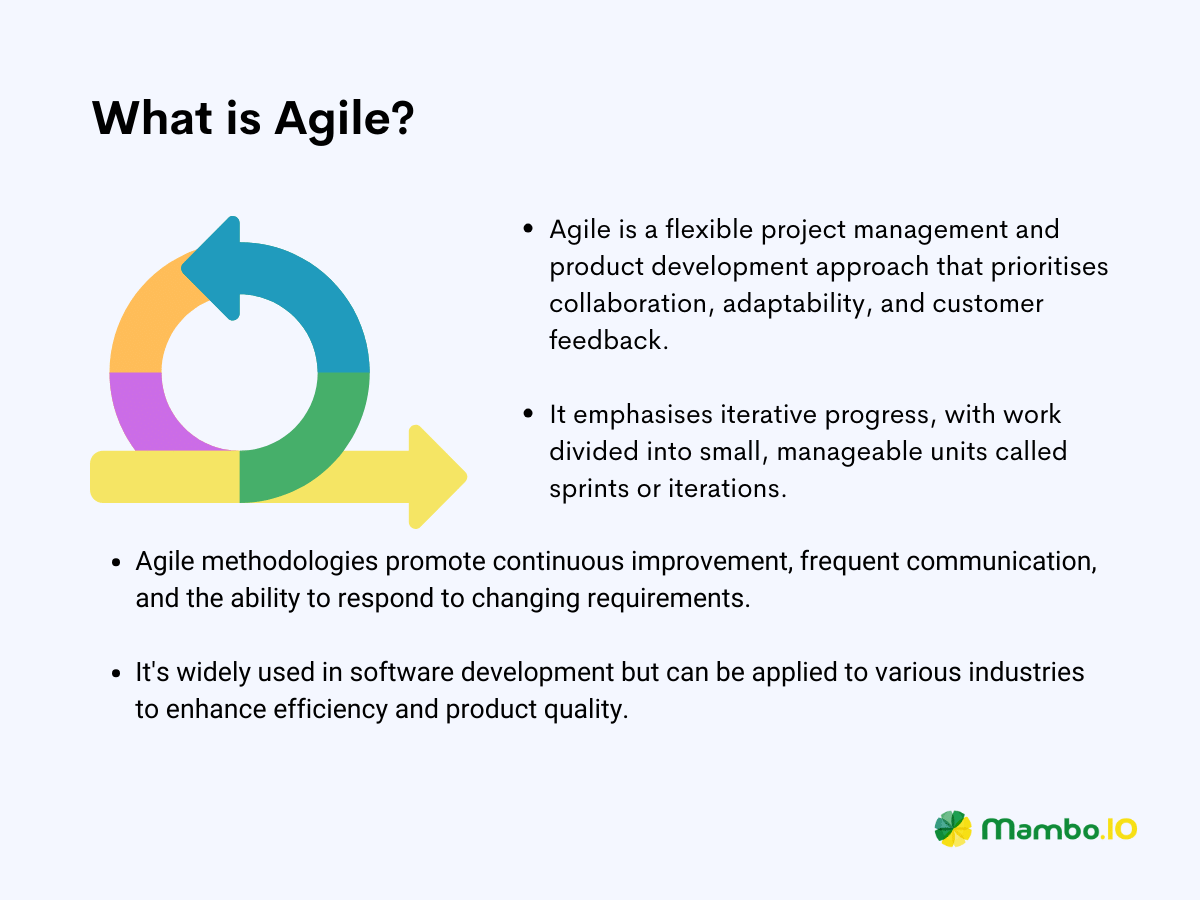
One of the fundamental principles of Agile is adaptability, meaning requirements and priorities can evolve throughout the project. Agile can appeal to any project manager because it enables them to respond swiftly to changing market conditions and product feedback. This agility eventually leads to delivering customer-focused and successful products.
Ultimately, Agile philosophy empowers any project manager to navigate the dynamic landscape of project management with precision and efficiency.
History of Agile
Agile is not just a methodology; it’s a philosophy that has revolutionised how teams approach product development.
Before Agile was the waterfall methodology
Agile roots can be traced back to the heyday of software development. Back then, traditional “Waterfall” methodologies were considered the gold standard for software development, characterised by a linear and sequential approach to projects. While effective, it involves extensive upfront documentation before you can even code.
It usually begins with a comprehensive business requirements document made by a business analyst. Once all the required business and technical documents are done, developers can code, integrate, and test. This extensive process had to be done before declaring the software production-ready. Unsurprisingly, this process often takes a couple of years to complete.
As technology evolved and projects became more complex, this methodology caused delays and unsatisfactory outcomes. This rigid approach is outdated and desperately needs an update – or a replacement.
The origins of the Agile methodology
The turning point for Agile was in 2001 when software developers realised they were working differently from the waterfall methodology. Thanks to this realisation, they’ve decided to create the Agile Manifesto. This is a document that contains their vision of how modern software development should operate.
Unsurprisingly, the principles within the manifesto align with the core beliefs of effective project management. From these principles originated the Agile methodology, an approach responsible for the success of many companies worldwide.
A brief look into the Agile manifesto
The Agile Manifesto is a set of guiding principles for modern software development teams to follow. It emphasises:
- Individuals and interactions over processes and tools – Developers should collaborate and communicate effectively instead of solely relying on tools or rigid processes.
- Working software over comprehensive documentation – Developers should focus on delivering functional software rather than excessive documentation.
- Customer collaboration over contract negotiation – Developers must emphasise active customer involvement and collaboration throughout the project instead of rigid contracts.
- Responding to change over following a plan – Developers must be adaptable to changing requirements rather than sticking strictly to initial project plans.
Product managers can also apply Agile project management to improve the effectiveness and adaptability of their product development processes.
The Agile process explained
The Agile process is a flexible methodology widely used for project management. It involves a set of principles and practices that prioritise collaboration, customer feedback, and the ability to adapt to changes. Here’s a simplified overview of the Agile process focusing on product managers like you.
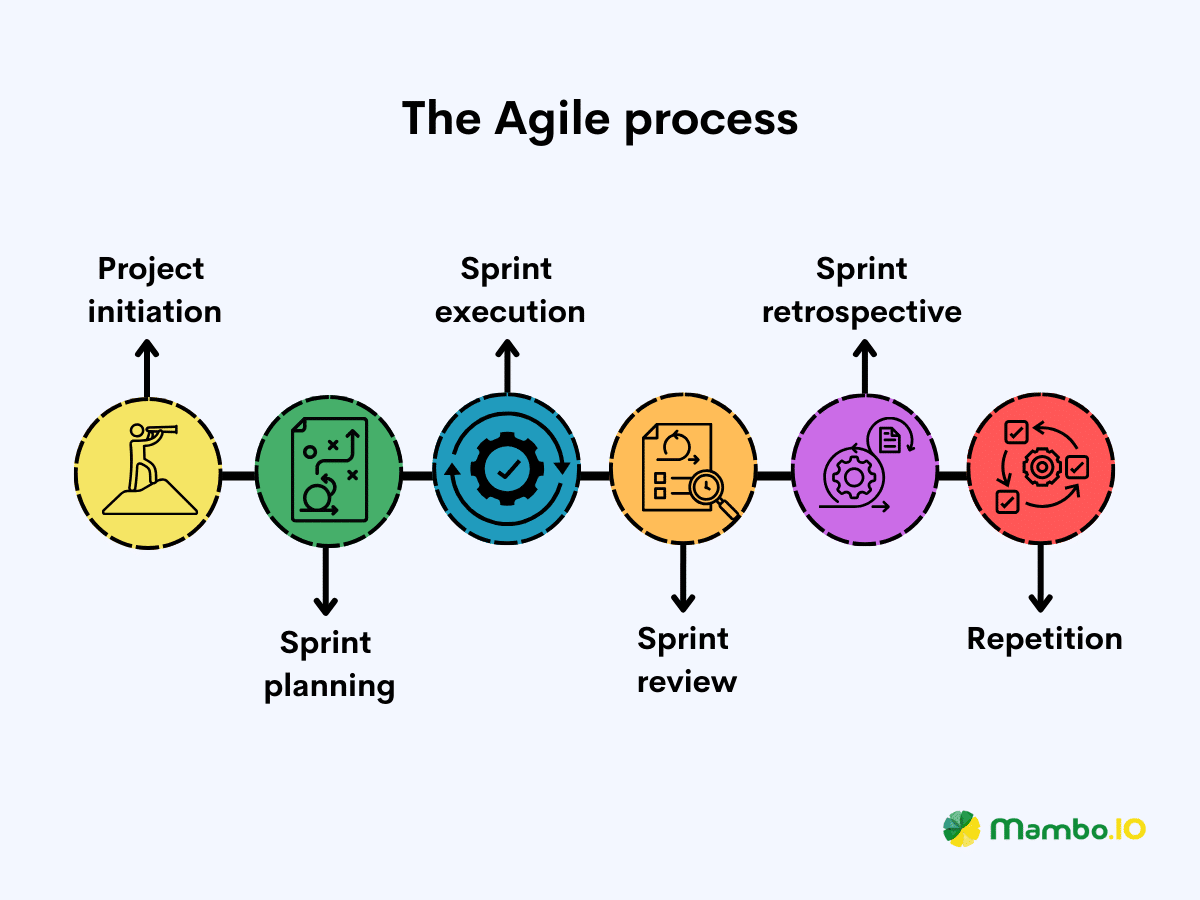
#1. Project initiation
Start by defining a clear vision for the product, aligning it with the organisation’s business goals and the customer’s needs. Product managers will then create and prioritise a product backlog of features, user stories, or tasks based on their importance.
#2. Sprint planning
Product managers will select items from the product backlog for the upcoming sprint. The selected items are broken down into smaller and actionable tasks. Then, they will establish a goal to provide a clear focus for the team during the sprint.
#3. Sprint execution
Afterwards, the team will hold daily stand-up meetings to discuss progress, challenges, and blockers they’ve encountered. The team members need to collaborate to develop and test the selected items. Their goal is to produce a shippable product increment by the end of the sprint.
#4. Sprint review and demo
At the end of the sprint, the team will demonstrate the completed work to stakeholders. These stakeholders will provide feedback on the demonstrated work, informing future priorities and adjustments.
#5. Sprint retrospective
Now, the team will conduct a retrospective to reflect on the sprint. Doing so enables them to identify what went well and what could be improved and take action for continuous improvement.
#6. Repetition
The team will repeat the process until the project is complete. Throughout the process, the project manager must continuously refine the product backlog based on feedback, market changes, and business needs.
Why does Agile stand out as a project management methodology?
Adopting the Agile philosophy has led numerous companies worldwide to success. It provides a framework for developing products that meet customer needs. More importantly, it’s made to enable product managers to respond quickly to change to deliver products effectively.
Let’s take a good look at some of the reasons why Agile stands out as a project management methodology.
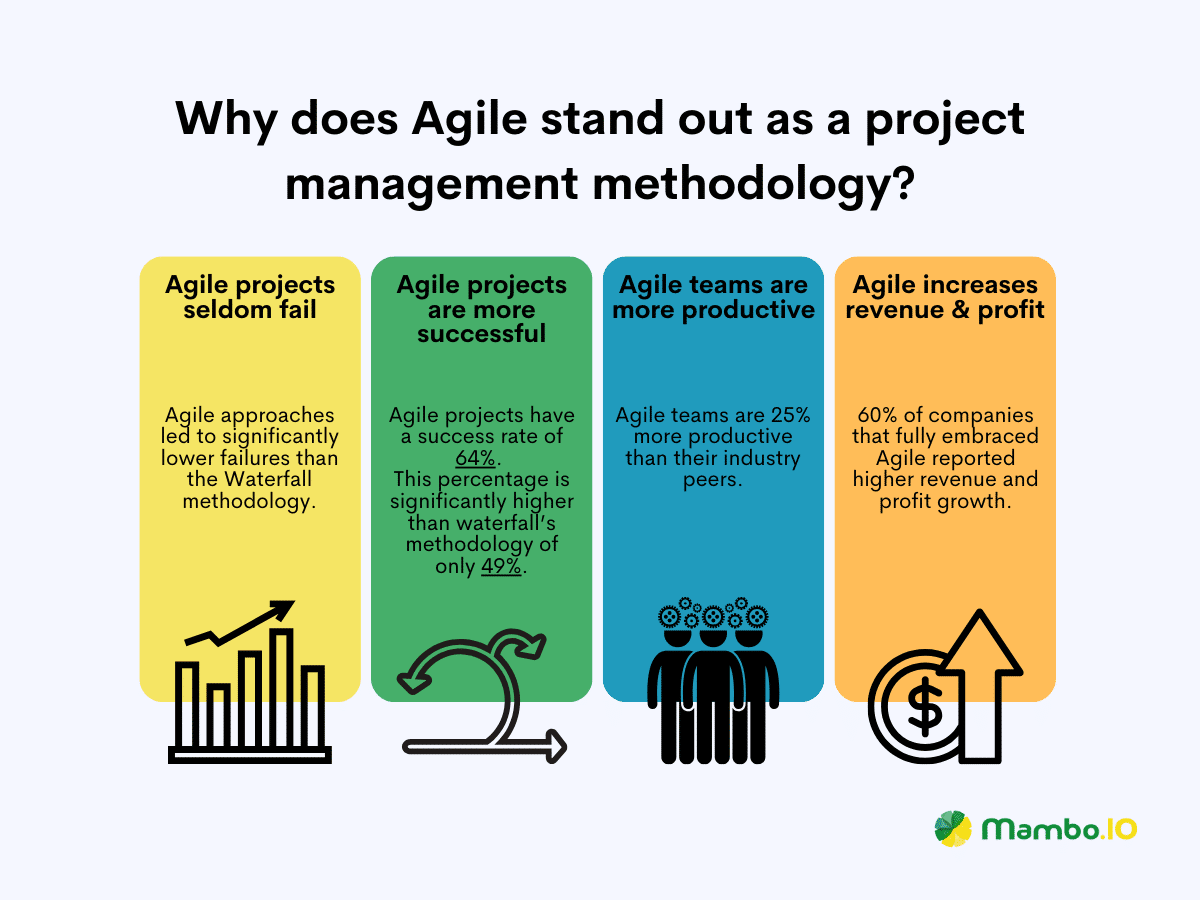
#1. Agile enables faster time-to-market
McKinsey & Company revealed that companies embracing Agile methodologies report up to 30% faster time to market for products.
#2. Agile projects are more successful than waterfall projects
Research from the 2020 Standish Group Chaos Study revealed that Agile projects outperform Waterfall projects with a 3x higher success rate.
#3. Agile teams are much more productive
A study by DeltaMatrix shows that Agile teams are 25% more productive than their industry peers. They are also 50% faster to market than teams who follow a non-Agile approach.
#4. Companies that went Agile reported higher revenue
Harvard Business Review said that out of 1,300 respondents, 60% reported higher revenue and profit growth than the rest. These companies are also the ones that fully embrace the Agile approach.
8 benefits of Agile

#1. Adaptability
Embracing Agile enables your project team to respond quickly to shifting priorities and evolving customer requirements.
#2. Customer-centricity
Agile prioritises customer needs and feedback, ensuring your product meets customer expectations.
#3. Faster time to market
You can deliver your products quickly thanks to Agile’s iterative approach and incremental progression.
#4. Better product quality
Agile’s continuous testing and integration system paves the way for better products.
#5. Clear prioritisation
Product backlogs help project managers prioritise what work needs to be done urgently.
#6. Continuous improvement
With systems like sprint retrospectives in place, teams can identify areas for enhancement in both the product and the development process.
#7. Empowered teams
Agile empowers teams to make crucial decisions and self-organise.
#8. Customer feedback integration
Agile promotes product development, leading to solutions that meet and sometimes exceed customer needs and expectations.
7 Drawbacks of Agile
#1. Scope creep
Agile’s adaptability can sometimes lead to scope creep, where new requirements or changes are introduced frequently during development.
#2. Documentation challenges
Since Agile is iterative, teams may need help to catch up on documentation.
#3. Dependency on team performance
Agile heavily relies on the performance and collaboration of cross-functional team members.
#4. Learning curve
Teams who have recently transitioned to Agile may initially find the process challenging.
#5. Resource and time-intensive
Project managers and developers must actively participate to make the methodology work, which consumes their time and resources.
#6. Continuous involvement
Continuously improving the product will require project managers to involve themselves in Agile projects constantly.
#7. Overemphasis on speed
Because Agile teams focus on delivering quickly, they may be tempted to forego quality.
Agile methodologies
#1. Scrum
Scrum is one of the most popular Agile methodologies and the subject of our discussion (we’ll get to that later). It organises work into time-boxed iterations called sprints, typically lasting about 2 to 4 weeks. It is usually implemented when managing the development of software development products. However, it can also be used for other business-related contexts.
#2. Kanban
Kanban emphasises visualising and managing work in progress (WIP). It involves using Kanban boards to track tasks as they move through different stages of completion. This method is highly flexible for workflow management and is suitable for continuous improvement. Kanban relies on communication and transparency to inform Agile team members about the project’s status.
#3. Lean
Lean Agile is the love child of lean manufacturing and lean IT principles. It minimises waste, optimises workflow, and delivers value through quality products efficiently.
In a nutshell, the methodology forces Agile teams to ruthlessly eliminate irrelevant activity that isn’t valuable to the product. It’s also important to remember that lean Agile can be used independently or alongside other Agile methodologies.
#4. Extreme programming (XP)
Extreme programming (XP) is an Agile software development approach that strongly emphasises engineering practices and customer feedback. It is driven by feedback, simplicity, and adaptability, focusing on delivering quality and meeting evolving customer requirements.It encourages trust by accommodating changes in customer requirements. More importantly, it actively involves them to gather feedback and deliver an excellent product.
#5. Adaptive project framework (APF)
The adaptive project framework (APF) is an Agile methodology that focuses on adapting to changing circumstances and project scope. It emphasises the core principle of “learning by doing” and prepares teams to anticipate and respond to unexpected factors. Moreover, it achieves adaptability by breaking projects into iterative phases, enabling teams to assess and adjust their approach regularly. Doing so keeps them on track with timelines and responds swiftly to changes.
Successful use cases of Agile
Cisco
Cisco initially implemented the Waterfall method for its Subscription Charging Platform (SBP). This approach proved to be ineffective as years went on, and it slowed down their development process. It resulted in delays, missed deadlines, quality issues, and overtime due to separate teams working sequentially.
Eventually, they adopted the Scaled Agile Framework (SAFe) and conducted daily 15-minute meetings to coordinate progress and tasks. These meetings allowed teams to self-manage and make themselves accountable through status updates.
They’ve also introduced three Agile release trains for capabilities, defects, and projects. Doing so resulted in on-time SBP releases without overtime, a 40% reduction in defects, and a 14% increase in defect removal efficiency.
Barclays
Barclays initiated an organisation-wide Agile transformation to integrate and enhance its scattered teams. They’ve decided to adopt the Disciplined Agile Delivery (DAD) approach, introduced Agile coaching, and transformed workspaces for better collaboration.
The results were impressive.
Over 800 teams embraced Agile within a year, leading to a 300% increase in throughput. Additionally, code complexity dropped by 50% across 80 applications, and the test code average improved by 50%. More importantly, their teams reported increased happiness, faster product launches, and better adaptability to feedback.
This transformation enabled Barclay to improve its customer rates post-COVID and share its successful strategies with small businesses.
How to adopt Agile
If you’re considering a complete Agile switch, understand why your team and organisation may want this change. Each cross-functional team member has their pain points and sees unique areas for improvement. And if your decision is final, ensure everyone understands their assigned roles and responsibilities.
Steps to adopt the Agile methodology
Here’s a quick rundown of how you can adopt the Agile way.
- Familiarise yourself with the Agile principles.
- Choose an Agile methodology that suits your workflow best.
- Assemble a cross-functional team with members from various departments (development, design, quality assurance, etc.).
- Create a clear product vision and roadmap, then define your product’s goals and objectives.
- Develop a prioritised product backlog.
- Plan sprints with your team to work on the items included in the product backlog.
- Keep everyone on the team aligned by conducting daily standup meetings.
- Release minor incremental updates to your product to allow for quick adaptation based on user feedback.
- Use retrospectives to identify areas for enhancement and implement changes in your process.
- Invest in project management tools like Jira, Trello, or Asana to help manage your Agile processes effectively.
- Consider getting certified in Agile methodologies to enhance your capabilities in Agile environments.
What is Scrum?
Scrum is an Agile project management framework that encourages cross-functional teams to collaborate effectively in delivering high-quality products. Like a sports team’s training regimen, Scrum enables teams to self-organise and continually improve by learning from their experiences.
It provides a structured approach to product development, emphasising teamwork, accountability, and iterative progress.
This methodology is famous for its adaptability, speed, and effectiveness in delivering value to customers throughout the product’s development. The primary goal of Scrum is to satisfy customer needs by fostering transparent communication, collective responsibility, and continuous progress.
Scrum’s iterative and incremental processes ensure that the project remains responsive to changing requirements and delivers a product that aligns with customer expectations.

History of Scrum
The Scrum methodology has come a long way from its genesis. Let’s take a brief look at the history of Scrum and how it ended up as the impressive framework that it is today.
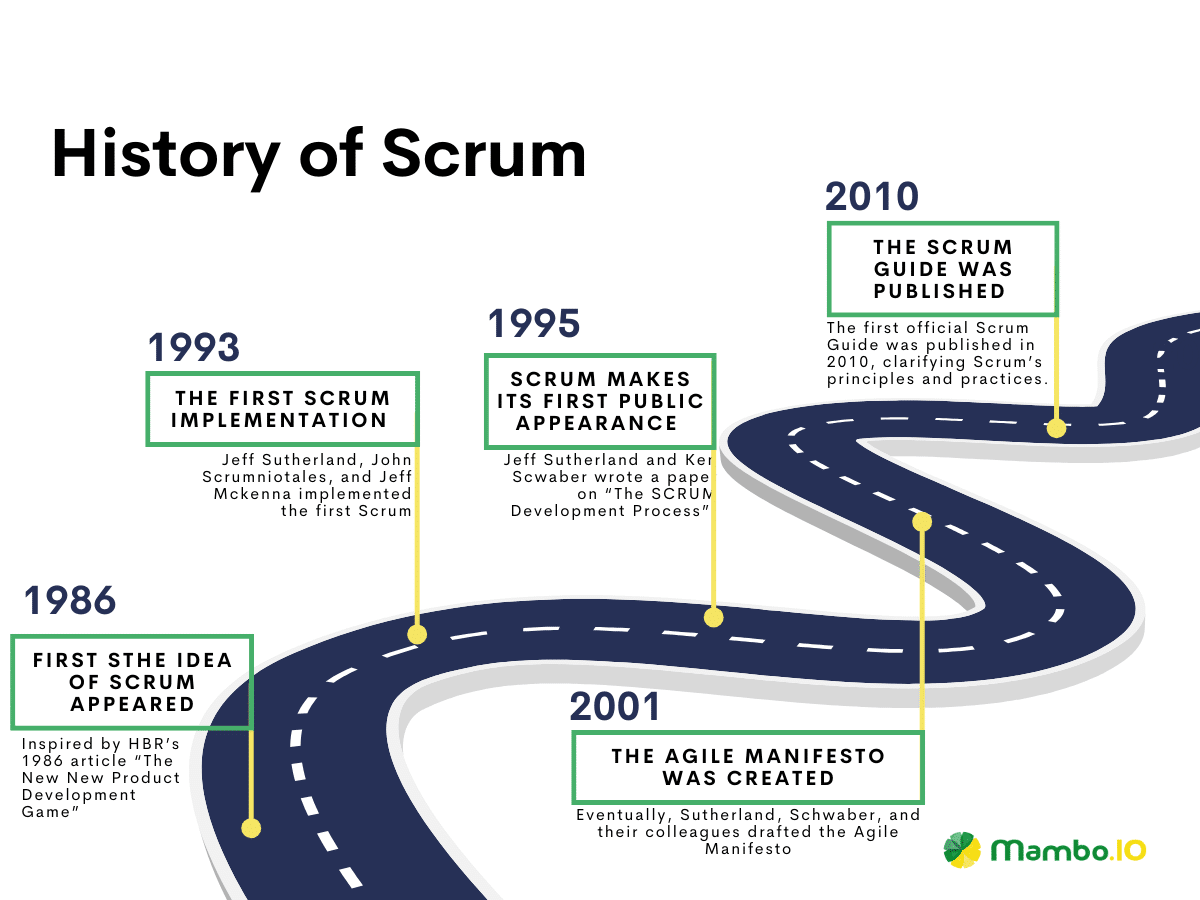
1986 – The idea of Scrum appeared
The history of Scrum dates back to the mid-1980s when it was first introduced as a framework for product development. It was inspired by an article in the Harvard Business Review 1986 titled “The New New Product Development Game”. This article by Takeuchi and Nonaka highlighted the importance of self-organised teams and introduced a “rugby approach” to product development.
1993 – First Scrum implementation
The first implementation of Scrum happened in 1993 at the Easel Corporation by Jeff Sutherland, John Scrumniotales, and Jeff Mckenna. They compared the traditional development process to a relay race and proposed a more flexible and collaborative rugby approach.
1995 – Scrum makes its first public appearance
Thanks to their inspiration from Takeuchi and Nonaka’s article, Jeff Sutherland and Ken Scwaber wrote a paper on “The SCRUM Development Process”. They presented this paper at the OOPSLA Conference in 1995, marking Scrum’s first public appearance.
2001 – The Agile Manifesto was created
Eventually, Sutherland, Schwaber, and their colleagues drafted the Agile Manifesto in 2001. As you already know, this document promoted a radically different approach to the software development process. Since then, Scrum has grown thanks to contributors like Mike Cohn, who developed user stories and story points to describe and measure work.
2010 – The Scrum guide was published
The first official Scrum Guide was published in 2010, clarifying Scrum’s principles and practices. Over the years, Scrum has evolved and gained widespread adoption, extending beyond software development into other industries. Until now, it continues to shape the world of work, promoting agility in teams and organisations worldwide.
The Scrum process explained
The Scrum process is similar to the Agile process we discussed earlier, with some minor differences. Let’s explore how Scrum works.
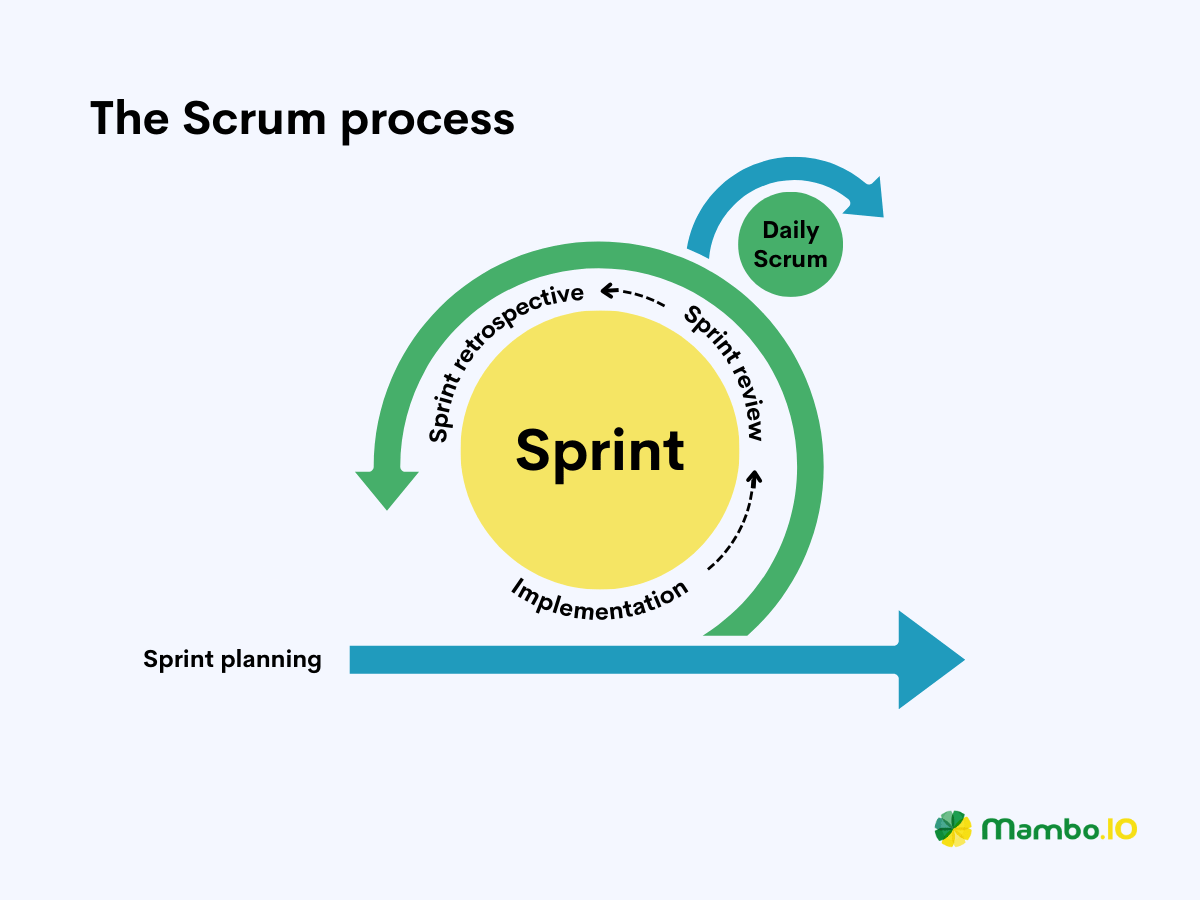
#1. Product backlog
Everything in Scrum begins with a prioritised list of tasks, features, and improvements known as the product backlog. Product owners will curate and refine this list based on their business goals and customer needs.
#2. Sprint planning
Sprint planning is a Scrum event that jumpstarts the sprint. This planning aims to define the work to be done and how the team can accomplish it. During this time, the team will select items from the product backlog to work on for the next sprint.
#3. Sprint
The work chosen by the team will be done in a time-boxed period known as sprints. These events typically last two to four weeks, providing a focused and efficient work cycle.
#4. Daily Scrum
The team will have to meet daily for short standup meetings, known as daily Scrums, to discuss the work. During these meetings, the team will discuss their progress, roadblocks, and plans for the day.
#5. Sprint review
At the end of each sprint, the team will hold a sprint review to showcase their completed work to stakeholders. The feedback gathered from this event will be helpful for the other upcoming sprint priorities.
#6. Sprint retrospective
The sprint retrospective immediately occurs after the sprint review finishes. During this time, the team will reflect on their recent sprint and discuss what went well and what could be improved. More importantly, they’ll discuss what adjustments are needed for the next sprints.
#6. Repeat
Finally, the process will repeat itself. The product owner will select new items from the backlog and assign them to the team for the next sprint.
4 major elements of Scrum
Scrum revolves around four primary elements, each crucial in guiding teams towards successful outcomes. These elements encompass roles, events, artifacts, and rules, providing a structured yet flexible approach to product development.
#1. Scrum roles
Product owner
The product owner is in charge of representing the customer regarding their needs and priorities. They define and manage the product backlog, which is a prioritised list of features and requirements. The product owner ensures the team works on the most valuable items and clarifies what needs to be built.
Scrum master
The Scrum master ensures the team follows Scrum principles and practices.
They are also tasked to remove obstacles that hinder the project’s progress. They are servant leaders who foster an environment where Scrum principles and methodology can thrive.
Development team
The development team is a cross-functional group responsible for delivering the product. They work together to complete the items from the sprint backlog during each sprint. The team is self-organising and responsible for deciding how to achieve the sprint goal.
#2. Scrum artifacts
A Scrum artifact is a tool to capture and communicate essential information about the product and the work to be done. Think of them as tools needed by the team to solve problems. The three Scrum artifacts include the product backlog, sprint backlog, and increments.
Product backlog
The product backlog is a list of the work the team needs to get done. It often consists of features, enhancements, bug fixes, and other work items that must be addressed in the product. The product owner manages it and serves as the single source of truth for what needs to be built. The items in the backlog are referred to as user stories or product backlog items (PBIs), representing customer needs.
Sprint backlog
The sprint backlog is a subset of items from the product backlog that teams must finish during a specific sprint. The items in the sprint backlog will be picked based on the team’s priority and the value they provide to the customers. Sprint backlogs can change during the sprint as the team gains a better understanding of what they’re doing.
Increments
The increment represents the sum of all the completed and potentially shippable work items in the current sprint. At the end of each sprint, the increment should always be ready for a possible release. This must be done whether the increment will be delivered to the market must be done.
#3. Scrum events
Scrum events, often called ceremonies, are essential meetings and time-boxed gatherings within the Scrum framework. These events provide a structured rhythm for the team to collaborate, inspect progress, and adapt to changes effectively. Below are the four main Scrum events.
Sprint planning
Sprint planning is an event where the product owner and the development team will select the items for the sprint. They will also leverage this time to define the work that they’ll have to do for the given duration. This planning also includes the steps they’ll need to take to achieve the sprint goal.
Daily Scrum
The daily Scrum is a meeting where the team gathers to discuss progress share updates, and plans for the day. This meeting is brief and usually lasts no more than 15 minutes. Daily Scrums are an excellent opportunity to synchronise and address any impediments or issues the team may encounter.
Sprint review
At the end of each sprint, the Scrum team conducts a sprint review to showcase the work completed. During this event, the team demonstrates the potentially shippable product increment while simultaneously gathering feedback. Ultimately, the goal of the sprint review is to ensure alignment with the product vision and customer expectations.
Sprint retrospective
The sprint retrospective is a reflective meeting where the Scrum team assesses its performance and identifies improvement areas. This event is also held at the end of each sprint.
#4. Scrum principles
Scrum follows principles and guidelines that allow teams to implement the framework effectively. The principles that guide the Scrum methodology are as follows:
- Empirical process control – Decisions should be based on observation and experimentation rather than pre-defined plans.
- Self-organisation – Scrum teams are expected to be self-organising, meaning they have the autonomy to make decisions on how to achieve the sprint goal
- Time-boxing – Scrum revolves around urgency to ensure teams can move forward to the next task as soon as possible.
- Focus on value – Emphasis on delivering value to the customers.
- Iterative development – Building products incrementally allows teams to adapt to customer needs and modify the product and outputs.
- Collaboration – Close collaboration between teams and stakeholders is essential for delivering customer value.
7 Benefits of Scrum
There are a handful of good reasons why businesses prefer using Scrum. Here are some of the prominent benefits of utilising this practical methodology.
#1. Adaptability
Scrum is highly adaptable and allows teams to respond quickly to changing requirements or product conditions.
#2. Boosts product delivery
It accelerates product delivery and enables teams to commit to what they can realistically achieve.
#3. Continuous improvement
The sprint retrospective encourages teams to reflect on their processes and identify opportunities for continuous improvement.
#4. Higher-quality products
Scrum practices lead to the development of higher-quality products with fewer defects.
#5. Efficient resource allocation
Scrum helps allocate resources efficiently by focusing on the most valuable features and tasks first.
#7. Morale boost
Development teams don’t have a boss and can self-organise, boosting morale.
7 Drawbacks of Scrum
Like any other methodology, Scrum brings its fair share of disadvantages. This is one of the reasons why many organisations combine Scrum with other project management techniques. Let’s go over these drawbacks.
#1. Implementation
Implementing Scrum can be challenging, especially for larger organisations.
#2. Short-sighted
Scrum’s focus on short iterations can make it challenging to predict long-term project outcomes accurately.
#3. Documentation
It favours working software over comprehensive documentation, so producing documents for compliance and regulatory purposes can be difficult.
#4. Scope creep
Without careful project management, Scrum projects can suffer from scope creep.
#5. Lack of clarity
Scrum may not be the best choice for projects that require a stable and well-defined scope from the outset.
#6. Team dependency
Scrum heavily relies on team collaboration.
#7. Too much focus on speed
Scrum’s overemphasis on speed can sometimes lead to a rush to complete tasks at the expense of quality.
Successful use cases of Scrum
Adobe
Adobe Systems has relied on Scrum for several years as its primary product development method. Some of their products, like Premiere Pro and After Effects, use Scrum to efficiently deliver high-quality solutions to their customers.
Spotify
Spotify has adopted an Agile approach for its music streaming service and achieved excellent results. The company organises its employees into squads responsible for a specific app function.This enables Spotify to allocate tasks to squads without worrying about a faulty commit disrupting the entire streaming platform.
IBM
The tech giant IBM has successfully embraced Agile Scrum methodologies, significantly enhancing its business operations. IBM offers project management software incorporating Agile development, known as the IBM Rational Team Concert. The transformation focused on three key areas: Process, People, and Tools, resulting in substantial improvements.
How to adopt Scrum
Adopting the Scrum methodology isn’t a walk in the part, but it’s not rocket science. If you want to implement Scrum successfully, you’ll need to follow the steps below.
#1. Understand the Scrum basics
First and foremost, you need to familiarise yourself with the fundamental principles of Scrum. Dive deeper into elements like Scrum roles, events, and artifacts.
#2. Appoint a product owner and find a Scrum master
Designate a product owner responsible for defining and prioritising the product backlog. They will represent the customer’s interests and ensure the team delivers value. You must also find a Scrum practitioner to serve as your Scrum master.
#3. Build a Scrum team
Assemble a cross-functional team of people with the skills you need to deliver the product. These people typically include developers, designers, and testers.
#4. Plan sprints
The product owner must effectively plan the sprints, which usually last 2-4 weeks. They must select items from the product backlog to work on during the sprint.
#5. Hold daily Scrum meetings
Conduct daily Scrums to discuss their progress and keep them short and focused as much as possible.
#6. Conduct sprint review and retrospective
Hold a sprint review and let the team showcase their completed work. Then, follow up with a retrospective to identify improvements and discuss what went well and what needs adjustments.
#7. Iterate and improve
Continuously refine your Scrum process based on feedback and results. More importantly, adapt and make improvements to enhance your team’s efficiency and product quality.
#8. Embrace the Scrum values
Go all in and embrace the Scrum values by encouraging the team to be open, courageous, committed, focused, and respectful. These values will foster a collaborative and productive work environment where the Scrum methodology can thrive.
So, is Scrum just Agile?
After everything you’ve read, there’s probably one question in your mind right now about the Agile vs. Scrum dilemma.
Is Scrum just Agile?
Technically, Scrum is Agile. However, Agile is not Scrum.
Confusing, isn’t it? Let us explain.
Regarding Agile vs. Scrum, you must understand that Scrum belongs to Agile’s broader methodology. And while both Scrum and Agile prioritise continuous improvement, they differ in scope.
Agile is a philosophy deeply rooted in the principles of the Agile Manifesto, emphasising iterative deployment. In contrast, Scrum is a specific framework for implementing Agile principles in product development. Agile encompasses Scrum and frameworks like Kanban, Extreme Programming, and Adaptive Project Framework.
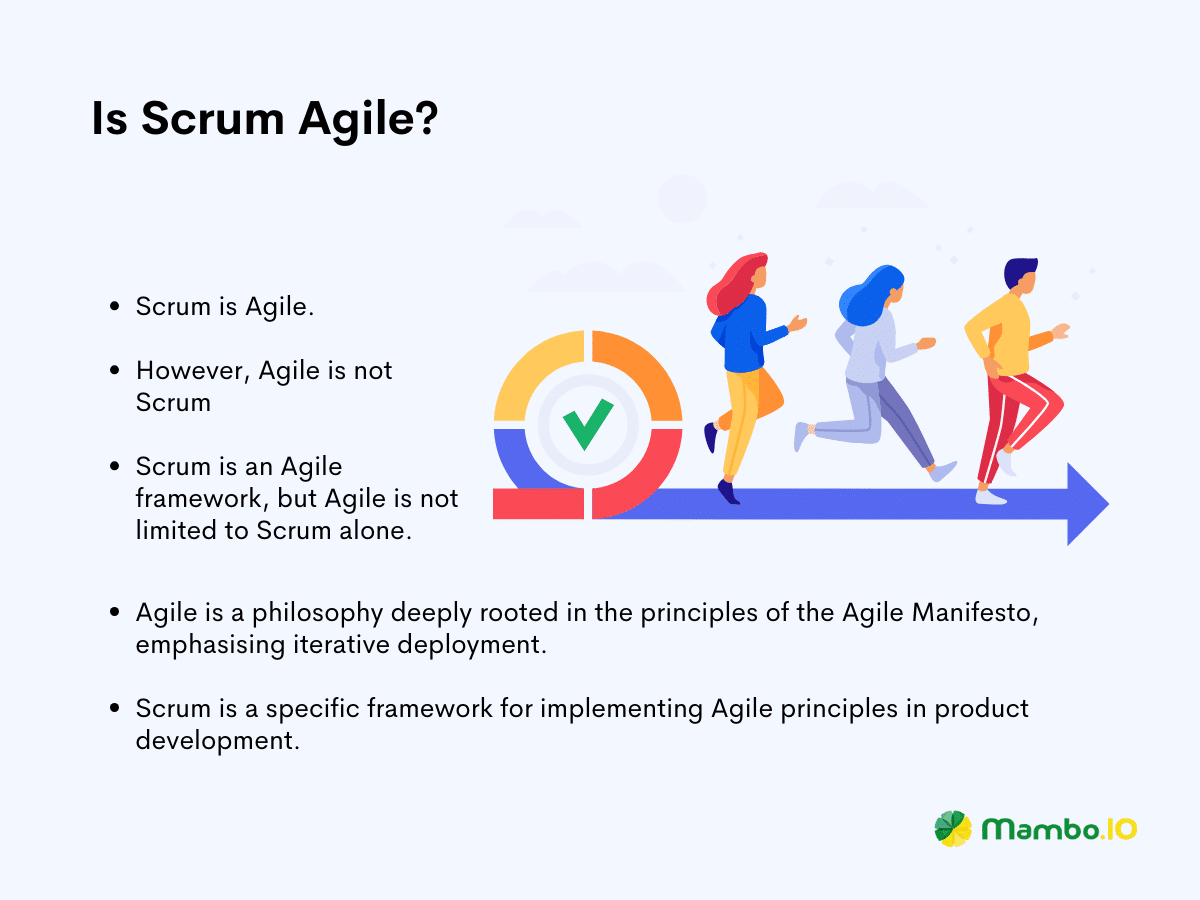
To keep things clear, Scrum is an Agile framework, but Agile is not limited to Scrum alone. Project managers should understand this distinction to manage their product development processes effectively.
Agile vs. Scrum: what are the differences?
Since Agile and Scrum follow the same system, it’s understandable that they have similarities. However, they have differences that make one unique from the other.
#1. Scope
Agile is a broader methodologies that’s deeply rooted in the principles found in the Agile Manifesto.. It emphasises iterative development, customer collaboration and quick responses to change.
On the other hand, Scrum is a specific framework and a part of the broader list of Agile methodology. It provides a structured approach to implementing Agile principles, particularly in software development.
#2. Philosophy vs. methodology
The Agile vs. Scrum dilemma can easily be solved by understanding how the two differ in structure.
Agile methodology is more of a philosophy guiding how teams approach work. It promotes flexibility, customer-centricity, and collaboration.
On the contrary, Scrum is a methodology with defined roles, events, and artifacts. It prescribes the team-specific features for them to follow.
Agile is a mindset, while Scrum is the means to an end.
#3. Flexibility
Agile is highly flexible and adaptable, encouraging teams to choose the best practices and processes for their line of work. As for Scrum, it provides a more structured approach. Because of this structure, it offers less flexibility in terms of process customisation.
#4. Roles
When talking about Agile vs. Scrum, we can’t go around the idea of setting roles. Agile doesn’t necessarily prescribe roles and favours cross-functional teams and collaboration among team members and stakeholders. As for Scrum, there are definite roles to fill, such as the product owner, the Scrum master, and the development team. These roles have well-defined responsibilities to do within the framework.
#5. Time-boxed iterations
Agile projects can have flexible time frames so teams can continually work until they meet customer requirements. But when it comes to Scrum, it has fixed-length iterations called sprints that last for 2 to 4 weeks.
#6. Delivery
You can expect products to be delivered regularly. However, you can’t say the same for Scrum because it only delivers increments after every sprint.
#7. Design and execution
Agile focuses on simplicity in process design and execution, while Scrum encourages innovation and experimentation.
When should you use Agile?
The best time to go Agile is when working with projects with unclear constraints, timelines, or available resources. It excels in ongoing projects and those facing unforeseen challenges, such as designing and launching new products.
With Agile, you can test and iterate quickly, adapting to changes whenever necessary. This approach is ideal for minimum viable products (MVPs) and startups because it allows quick delivery and cost savings. Additionally, frequent deliveries and feedback in Agile can also boost team motivation.
When should you use Scrum?
Scrum is ideal when you’re dealing with work that’s uncertain or difficult to estimate due to its unfamiliar nature. It shines the brightest in situations where projects are highly unpredictable, standardisation isn’t a priority, and the market rapidly evolves. More importantly, you can use Scrum to bridge the gap between business stakeholders and development teams.
Ultimately, Scrum excels when continuous feedback, team autonomy, and regular delivery are critical. Its adaptability is also valuable for handling projects with many unknowns or evolving requirements. Because of this, it’s a strong candidate for effective project management.
When to use a hybrid approach
There are times when both Agile and Scrum work. When that time comes, you must set aside the Agile vs. Scrum quarrel and try a hybrid approach. Some of the best hybrid approaches are the following:
- Disciplined Agile Delivery (DAD)
- Scaled Agile Framework (SAFe)
- Large Scale Scrum (LeSS)
These are just some of the Agile and Scrum hybrid methodologies used today. They offer flexibility and customisation to meet various projects and organisations’ unique requirements and constraints. Choosing which hybrid approach to use depends on project size, complexity, and organisational culture.
Agile vs. Scrum: a head-to-head comparison
Here’s a head-to-head comparison to settle the beef between Agile vs. Scrum once and for all.
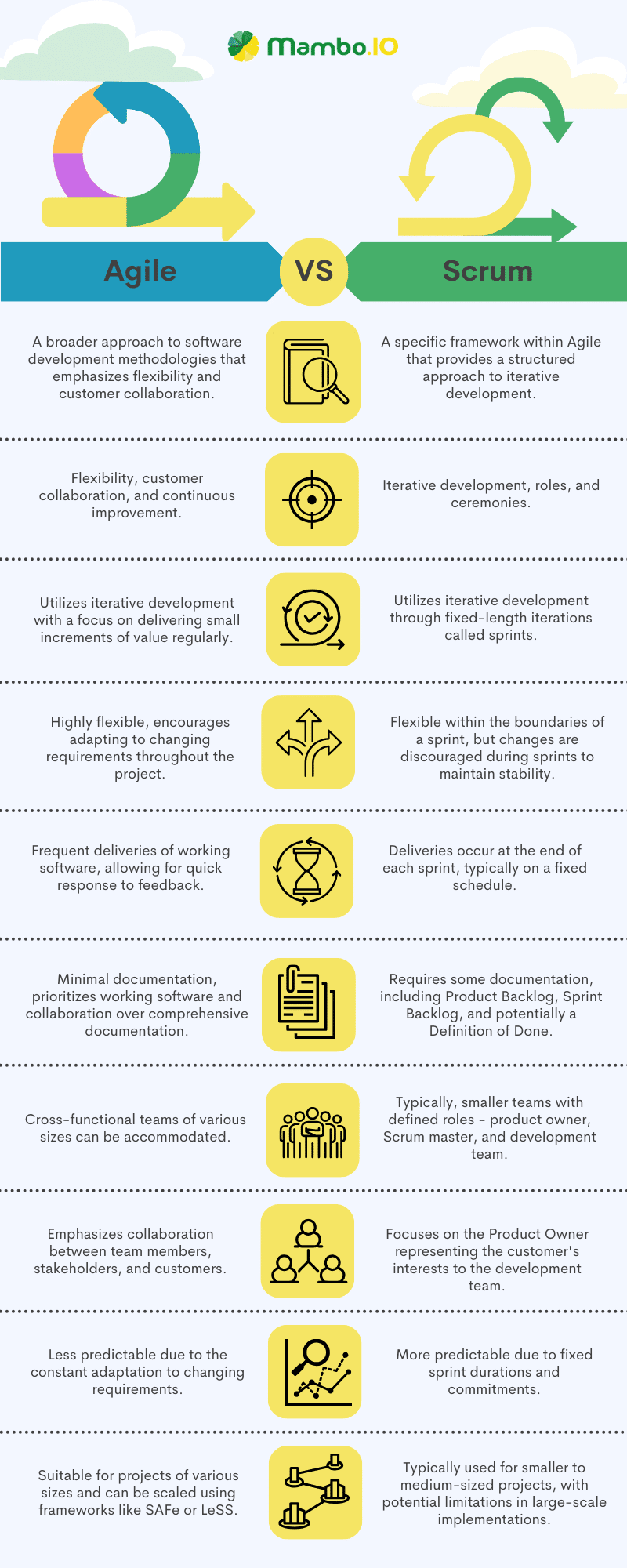
Agile vs. Scrum: choosing the right methodology for your team
It’s critical to understand that the right methodology is the one that empowers your team. It must also allow your team to adapt to change gracefully. Ultimately, it must deliver the value you’ve promised to your customers.
In the dynamic world of project management, your key to success is to stay Agile and open to improvement. Ultimately, the correct methodology, whether Agile or Scrum, will empower your team to deliver efficiently and satisfy your customers.
Here at Mambo.io, we equip product managers with an effective tool to solve their user engagement problems: gamification. With our platform, you can leverage gamification to drive engagement and get better results. Book a demo today to discover the wonders gamification can bring to your organisation!
Download your free
“Gamification Guide”
Get your PDF now and start transforming your approach to digital engagement!
Latest Posts
Machine Learning In Finance: 12 Essential Applications
The impact of machine learning on finance is significant. Thanks to this technology, financial institutions are now equipped to make efficient decisions. Through the analysis of data sets, machine learning […]
How To Create Interactive Compliance Training For Bank Employees
Banking compliance training isn’t just another task. It’s the stage where everything else performs. Banks must navigate a myriad of regulations and laws. After all, this is a trust-driven, high-stakes […]
How Fintech Apps Are Using Gamification To Increase User Engagement
Discover how gamification in fintech is revolutionizing financial engagement, making banking fun & boosting user loyalty.





